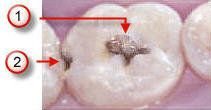Bonding Before Bonding is a cosmetic dentistry procedure that enables the restoration of chipped, spotted, discolored or gapped teeth. We use modern materials that match the shade, translucency, and texture of your teeth. Our goal is to have the end result appear as if no treatment was performed.
Read more
Cosmetic and Restorative Dentistry
There are many reasons why adult teeth may need restorative treatment. The most common reason is decay, followed by fractured teeth, and old restorations needing replacement. If we recommend that a tooth with a cavity be treated and more than a few weeks pass after the initial diagnosis, the cavity will almost always get bigger and can cause pain. Once this happens, it will likely require more extensive and expensive treatment. The tooth may even have to be removed and replaced with a false (or artificial) tooth. If you have a cavity and it needs a restoration, there are different kinds of materials that may be used to restore the functionality of the tooth. Please remember that a tooth may need treatment before it causes pain. If a tooth causes pain, it may be able to be saved, but the treatment time and cost typically increase due to the complexity of the necessary procedures.
How a Cavity Forms
 A cavity is a very small hole that forms on the surface, side, or root of a tooth. Cavities are caused when sugars in the food you eat combine with the bacteria in your mouth. This combination produces a mild acid that eats away at the enamel, the hard outer layer of your tooth. Cavities can occur at any age, but most occur during childhood when dental hygiene may be less thorough. There is a genetic component to dental health, including teeth, gums, and the bone that holds the teeth. No matter how good your genes are, if you don’t take good care of your teeth you may be prone to very serious consequences.
A cavity is a very small hole that forms on the surface, side, or root of a tooth. Cavities are caused when sugars in the food you eat combine with the bacteria in your mouth. This combination produces a mild acid that eats away at the enamel, the hard outer layer of your tooth. Cavities can occur at any age, but most occur during childhood when dental hygiene may be less thorough. There is a genetic component to dental health, including teeth, gums, and the bone that holds the teeth. No matter how good your genes are, if you don’t take good care of your teeth you may be prone to very serious consequences.
Babies tend to get cavities on the front teeth, especially if they are given a bottle to sleep with. Even milk contains sugar that can harm teeth. This is referred to as baby bottle tooth decay. Children tend to get cavities on the chewing surfaces as well as in-between teeth. Adults can be at risk for both new and recurrent cavities.New cavities tend to form between teeth as well as on the root surfaces. The cavities that form between teeth are typically related to a lack of flossing. Cavities on the root surfaces of teeth generally occur because this area is not covered with enamel and is softer and more prone to cavities. The exposed root may be the result of hard brushing or bone loss related to gum disease. Cavities that reoccur form next to existing restorations such as fillings, crowns, bridges, etc. As restorations get old, the filling material can shrink or wear away, causing the possibility of a small space forming between the tooth and the restoration. This provides a prime area for bacteria to accumulate and breed decay. Click the link to do an experiment with fluoride to see how it helps fight cavities.
Cavities and Restoration Choices
As part of any visit to our office, we check all of your restorations such as crowns, fillings, bridges, veneers, etc. for any sign of decay or old age and we may recommend x-rays so that we can see inside and between your teeth. If we spot any cavities, we will recommend different options for restoring the tooth to full function. If the cavity is in the very early stages, we may decide to keep an eye on it and recommend a home fluoride rinse to help the tooth fight the cavity and possibly prevent the need for a restoration.
-
Bonding
Category: Dental Services, Cosmetic Dentistry
-
Bridges
Category: Dental Services, Cosmetic Dentistry
Bridges A missing molar The adjacent teeth prepared for a bridge When a tooth has been lost and healthy teeth are located on both sides of the newly missing tooth or teeth, then a fixed bridge is a treatment option. The other options are implants or a partial denture. The procedure for
Read more -
Crowns
Category: Dental Services, Cosmetic Dentistry
Crowns A severely chipped front tooth The tooth prepared for a porcelain crown When the structure of an entire tooth is compromised, a crown, which covers all of the surfaces of the tooth, will need to be placed. The example to the left illustrates a fractured front tooth. The first step
Read more -
Dentures
Category: Dental Services, Cosmetic Dentistry
Dentures Complete or partial dentures can replace your missing teeth and give you the confidence to smile. Dentures can be used to replace teeth that have been lost due to trauma, decay, or gum disease. It is important to replace missing teeth, not only because teeth help with eating food, but because
Read more -
Fillings
Category: Dental Services, Cosmetic Dentistry
Fillings How Teeth Are Restored After diagnosing the problem and devising a treatment plan, the next step to restore a tooth to health is to make you comfortable. We will give you a local anesthetic so that you do not feel any discomfort. After the decay is removed, the tooth is ready to receive
Read more -
Inlays and Onlays
Category: Dental Services, Cosmetic Dentistry
Restoring Back Teeth - Crowns, Onlays and Inlays Explained The cusp is the pointed or rounded projection on the chewing surface of the tooth. Molars typically have four cusps as shown by the four purple asterisks in the top image. Bicuspids, also called pre-molars, typically have two cusps as shown
Read more -
Teeth Whitening
Category: Dental Services, Cosmetic Dentistry
Teeth Whitening The natural color of teeth is not white. They are typically a shade of either yellow or gray and tooth color varies from person to person.The procedure to whiten teeth is fairly simple but there are some rules that need to be followed to achieve and maintain good results. Why teeth
Read more -
Veneers
Category: Dental Services, Cosmetic Dentistry
Veneers A severely chipped front tooth The tooth with a base for support and prepared for a veneer If the entire front of the tooth needs to either be repaired or cosmetically improved, one option is a porcelain veneer. A veneer, by definition, is an overlay with a thin layer of a fine or
Read more
Contact Us
Please download, print and complete New Patient Forms, and bring to the first appointment.
Office Hours
Monday:
9:00 am-2:00 pm
Tuesday:
10:00 am-6:00 pm
Wednesday:
10:00 am-6:00 pm
Thursday:
9:00 am-5:00 pm
Friday:
9:00 am-2:00 pm
Saturday:
Closed
Sunday:
Closed
